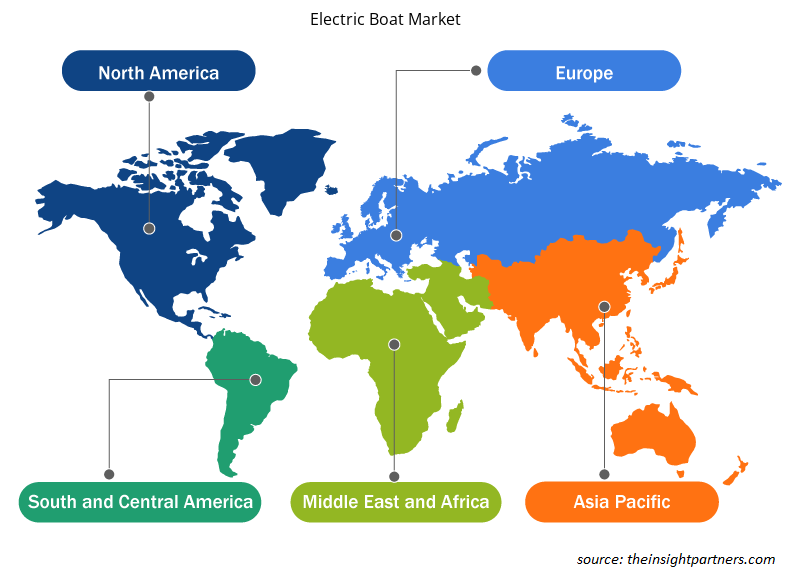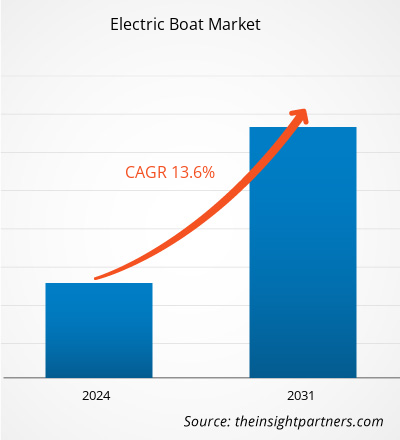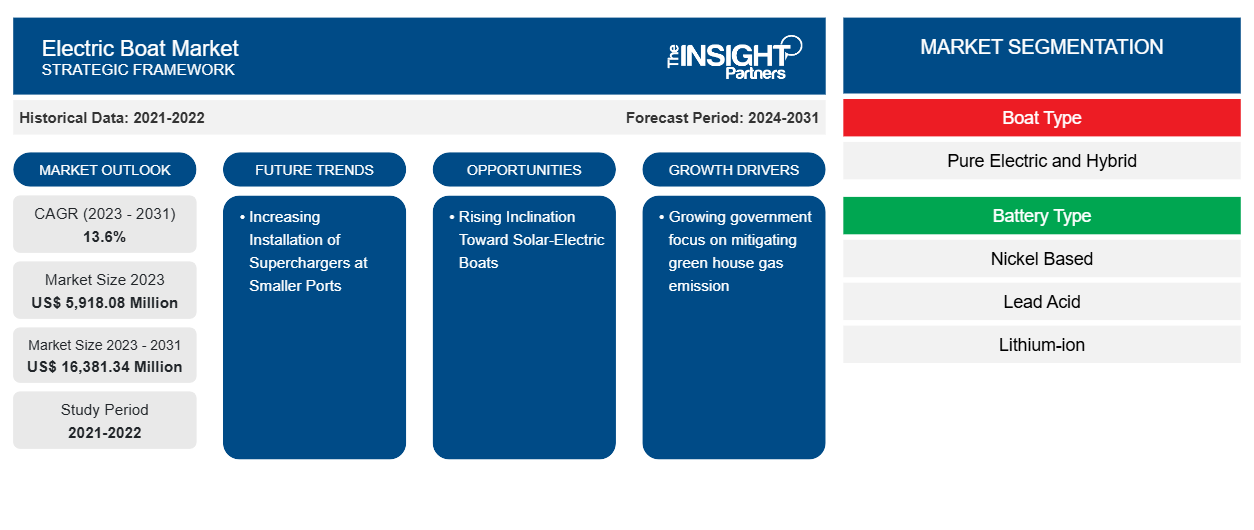Si prevede che la dimensione del mercato delle barche elettriche raggiungerà i 16.381,34 milioni di dollari entro il 2031, rispetto ai 5.918,08 milioni di dollari del 2023. Si prevede che il mercato registrerà un CAGR del 13,6% nel periodo 2023-2031. È probabile che la crescente installazione di compressori nei porti più piccoli rimanga una tendenza chiave nel mercato.
Analisi del mercato delle barche elettriche
Le aziende di barche elettriche si stanno concentrando sempre di più sul miglioramento dell'efficienza e dell'autonomia delle batterie potenziando l'infrastruttura di ricarica. La presenza di un gran numero di produttori di barche elettriche sta competendo su larga scala principalmente in base alla tecnologia di ricarica (caratteristiche) e alla disponibilità di presenza in tutto il mondo. Include Candela, Frauscher, Duffy Electric Boat Company e altri attori.
Panoramica del mercato delle barche elettriche
I principali stakeholder nell'ecosistema del mercato globale delle barche elettriche includono fornitori di materie prime, fornitori di componenti e clienti o utenti finali. Il fornitore di materie prime è uno stakeholder cruciale nell'ecosistema del mercato delle barche elettriche. Le parti principali della barca elettrica includono plastica, acciaio, alluminio, legno, gomma e tra le altre parti. I fornitori di componenti includono produttori di barche con parti marine e fornitori di caricabatterie. I principali utenti finali che richiedono barche elettriche sono i proprietari di barche e i fornitori di servizi di noleggio barche. I principali fornitori di materie prime includono Duffy Electric Boat Company, Evoy, RAND Boats e altri attori.
Personalizza questo report in base alle tue esigenze
Riceverai la personalizzazione gratuita di qualsiasi report, comprese parti di questo report, o analisi a livello nazionale, pacchetto dati Excel, oltre a usufruire di grandi offerte e sconti per start-up e università
-
Scopri le principali tendenze di mercato in questo rapporto.Questo campione GRATUITO includerà analisi di dati che spaziano dalle tendenze di mercato alle stime e alle previsioni.
Driver e opportunità del mercato delle barche elettriche
Crescente attenzione del governo alla mitigazione delle emissioni di gas serra per favorire il mercato
Il crescente inquinamento ambientale dovuto ai combustibili fossili è una delle principali preoccupazioni del governo. Per ridurre il livello di inquinamento ambientale, vari governi stanno sottolineando l'importanza che i consumatori adottino alternative più pulite, sostenibili e rispettose dell'ambiente, offrendo sconti speciali sulle vendite, incentivi, offerte vantaggiose e benefici fiscali. Cina, Giappone, Unione Europea, India, Canada e Corea del Sud sono alcune delle principali aree geografiche in cui i governi stanno lavorando attivamente per promuovere l'adozione di barche elettriche, che si prevede spingeranno l'evoluzione del mercato delle barche elettriche nel periodo di previsione. La crescente attenzione alla mitigazione delle emissioni di gas serra sta anche agendo come un importante motore di crescita per il mercato delle barche elettriche a livello globale.
Crescente inclinazione verso le barche solari-elettriche
Le barche elettriche solari presentano diversi vantaggi, tra cui la necessità di una bassa manutenzione dovuta all'assenza di cambio della girante dell'olio o di alterazione del filtro diesel, meno vibrazioni, buon risparmio di carburante, evitando la contaminazione locale e una riduzione del peso complessivo delle barche. L'energia solare supporta il controllo del flusso di elettricità verso batterie ricaricabili come quelle agli ioni di litio . Inoltre, le barche elettriche solari possono funzionare con basse spese operative, il che le rende l'opzione preferita dagli utenti rispetto alle barche a combustibile, in cui vi è un'elevata necessità di manutenzione regolare. Si prevede che questi vantaggi rafforzeranno la domanda di barche elettriche solari nei prossimi anni.
Analisi della segmentazione del rapporto di mercato delle barche elettriche
I segmenti chiave che hanno contribuito alla derivazione dell'analisi di mercato delle barche elettriche sono il tipo di imbarcazione, il tipo di batteria e l'applicazione.
- In base al tipo di imbarcazione, il mercato delle imbarcazioni elettriche è suddiviso in puramente elettriche e ibride. Il segmento puramente elettrico ha detenuto una quota di mercato maggiore nel 2023.
- In base al tipo di batteria, il mercato delle barche elettriche è suddiviso in batterie al nichel, al piombo e agli ioni di litio. Il segmento degli ioni di litio ha detenuto una quota di mercato maggiore nel 2023.
- In base all'applicazione, il mercato delle barche elettriche è suddiviso in pesca, ricreativo e altri. Il segmento ricreativo ha detenuto una quota di mercato maggiore nel 2023.
Analisi della quota di mercato delle barche elettriche per area geografica
L'ambito geografico del rapporto sul mercato delle barche elettriche è suddiviso principalmente in cinque regioni: Nord America, Asia Pacifico, Europa, Medio Oriente e Africa, Sud e Centro America.
L'ambito del rapporto sul mercato delle barche elettriche comprende Nord America (Stati Uniti, Canada e Messico), Europa (Russia, Regno Unito, Francia, Germania, Italia e resto d'Europa), Asia Pacifico (Corea del Sud, India, Australia, Giappone, Cina e resto dell'Asia Pacifico), Medio Oriente e Africa (Arabia Saudita, Sud Africa, Emirati Arabi Uniti e resto del Medio Oriente e Africa) e Sud e Centro America (Argentina, Brasile e resto del Sud e Centro America). In termini di fatturato, il Nord America ha dominato la quota di mercato delle barche elettriche nel 2023. L'Europa è il secondo maggiore contributore al mercato globale delle barche elettriche, seguita dall'Asia Pacifico.UAE, and the Rest of Middle East & Africa), and South & Central America (Argentina, Brazil, and the Rest of South & Central America). In terms of revenue, North America dominated the electric boat market share in 2023. Europe is the second-largest contributor to the global electric boat market, followed by Asia Pacific.
Approfondimenti regionali sul mercato delle barche elettriche
Le tendenze regionali e i fattori che influenzano il mercato delle imbarcazioni elettriche durante il periodo di previsione sono stati ampiamente spiegati dagli analisti di Insight Partners. Questa sezione discute anche i segmenti e la geografia del mercato delle imbarcazioni elettriche in Nord America, Europa, Asia Pacifico, Medio Oriente e Africa e Sud e Centro America.

- Ottieni i dati specifici regionali per il mercato delle barche elettriche
Ambito del rapporto sul mercato delle barche elettriche
| Attributo del report | Dettagli |
|---|---|
| Dimensioni del mercato nel 2023 | 5.918,08 milioni di dollari USA |
| Dimensioni del mercato entro il 2031 | 16.381,34 milioni di dollari USA |
| CAGR globale (2023-2031) | 13,6% |
| Dati storici | 2021-2022 |
| Periodo di previsione | 2024-2031 |
| Segmenti coperti |
Per tipo di barca
|
| Regioni e Paesi coperti |
America del Nord
|
| Leader di mercato e profili aziendali chiave |
|
Densità degli operatori del mercato delle barche elettriche: comprendere il suo impatto sulle dinamiche aziendali
Il mercato delle barche elettriche sta crescendo rapidamente, spinto dalla crescente domanda degli utenti finali dovuta a fattori quali l'evoluzione delle preferenze dei consumatori, i progressi tecnologici e una maggiore consapevolezza dei vantaggi del prodotto. Con l'aumento della domanda, le aziende stanno ampliando le loro offerte, innovando per soddisfare le esigenze dei consumatori e capitalizzando sulle tendenze emergenti, il che alimenta ulteriormente la crescita del mercato.
La densità degli operatori di mercato si riferisce alla distribuzione di aziende o società che operano in un particolare mercato o settore. Indica quanti concorrenti (operatori di mercato) sono presenti in un dato spazio di mercato in relazione alle sue dimensioni o al valore di mercato totale.
Le principali aziende che operano nel mercato delle barche elettriche sono:
- Frauscher Bootswerft GmbH & Co KG
- Società di imbarcazioni elettriche Duffy
- Barche Rand A/S
- Vision Marine Technologies Inc.
- Quadrofoil doo
- Artigianato in legno Budsin
Disclaimer : le aziende elencate sopra non sono classificate secondo un ordine particolare.

- Ottieni una panoramica dei principali attori del mercato delle barche elettriche
Notizie e sviluppi recenti sul mercato delle barche elettriche
Il mercato delle barche elettriche viene valutato raccogliendo dati qualitativi e quantitativi dopo la ricerca primaria e secondaria, che include importanti pubblicazioni aziendali, dati associativi e database. Di seguito sono elencati alcuni degli sviluppi nel mercato delle barche elettriche:
- Il costruttore di barche danese Rand Boats A/S ha presentato una nuova imbarcazione elettrica runabout chiamata Spirit 25, disponibile anche in una versione a gas. (Fonte: Rand Boats A/S, comunicato stampa, marzo 2022)
- Groupe Beneteau ha stretto una partnership con Vision Marine Technologies per sviluppare imbarcazioni completamente elettriche dotate di motori fuoribordo. (Fonte: Vision Marine Technologies, comunicato stampa, luglio 2022)
Copertura e risultati del rapporto sul mercato delle barche elettriche
Il rapporto "Dimensioni e previsioni del mercato delle barche elettriche (2021-2031)" fornisce un'analisi dettagliata del mercato che copre le seguenti aree:
- Dimensioni e previsioni del mercato delle barche elettriche a livello globale, regionale e nazionale per tutti i segmenti di mercato chiave coperti dall'ambito
- Tendenze del mercato delle barche elettriche e dinamiche di mercato come conducenti, limitazioni e opportunità chiave
- Analisi PEST e SWOT dettagliate
- Analisi del mercato delle barche elettriche che copre le principali tendenze del mercato, il quadro globale e regionale, i principali attori, le normative e i recenti sviluppi del mercato
- Analisi del panorama industriale e della concorrenza che copre la concentrazione del mercato, l'analisi della mappa di calore, i principali attori e gli sviluppi recenti per il mercato delle barche elettriche
- Profili aziendali dettagliati
- Analisi storica (2 anni), anno base, previsione (7 anni) con CAGR
- Analisi PEST e SWOT
- Valore/volume delle dimensioni del mercato - Globale, Regionale, Nazionale
- Industria e panorama competitivo
- Set di dati Excel
Report recenti
Rapporti correlati
Testimonianze
Motivo dell'acquisto
- Processo decisionale informato
- Comprensione delle dinamiche di mercato
- Analisi competitiva
- Analisi dei clienti
- Previsioni di mercato
- Mitigazione del rischio
- Pianificazione strategica
- Giustificazione degli investimenti
- Identificazione dei mercati emergenti
- Miglioramento delle strategie di marketing
- Aumento dell'efficienza operativa
- Allineamento alle tendenze normative























 Ottieni un campione gratuito per - Mercato delle barche elettriche
Ottieni un campione gratuito per - Mercato delle barche elettriche